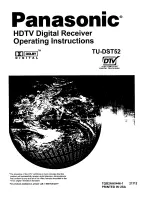
User’s Guide
Direct Digital Transmitter/Direct Digital Receiver
68-545-01 A
Printed in the USA
11 01
DDTX/DDRX DVI
DDTX/DDRX DVI • Installation
Description and Installation
2
Description
The
Direct Digital Transmitter (DDTX) half of the DDTX/DDRX
DVI pair accepts a Digital Visual Interface (DVI) signal or a
Digital Flat Panel (DFP) signal (with a DFP-to-DVI adapter) from
any device that outputs digital video. The DDTX creates
proprietary digital signals, and outputs the signals over coaxial
cable to the Direct Digital Receiver (DDRX) half of the pair. The
transmitter also sends and receives the bidirectional Display Data
Channel (DDC) signals on a separate set of connectors. The
receiver converts the digital and DDC signals back to DVI video,
and outputs it for use by a compatible display device. The
maximum separation between the DDTX and DDRX depends on
the cables used:
•
Maximum 150’ (45.72 meters)
— This limit applies to systems
using cable of the quality of Extron High Resolution cable.
•
Maximum 330’ (100.58 meters)
— This limit applies to systems
using cable of the quality of Extron Super High Resolution
cable.
The DDTX is rack mountable and has an internal switching
power supply.
The DDRX comes with its own external desktop power supply
and a detachable bracket for mounting the unit to a projector
mount or other convenient surface. The DDRX is also through-
or under-desk mountable with optional mounting kits.
Installation
1
.
Power off the computer and its local monitor.
2
.
For optional rack mounting, mount the DDTX on one side
of a 19" 1U Universal Rack Shelf (Extron part #
60-190-01
)
(figure 1).
False front panel
uses 2 front holes only
4-40 X 1/8 screws
Use 2 mounting holes
on opposite corners
DDTX DVI
DIRECT DIGITAL
TRANSMITTER
Figure 1 — Rack mounting a DDTX






















